SCSI-2 DF/W
@8EFC.ADF -
IBM PS/2 Fast/Wide SCSI Adapter (Uses same ADF as SE F/W)
C8EFC.ADF
- Init file for @8EFC.ADF
rev71upd.exe SCSI-2 Fast/Wide Adapter Firmware
Upgrade .71
corv77.exe SCSI-2 Fast/Wide Adapter Firmware
Upgrade .77
corvC9.exe SCSI-2 F/W Enhanced Fast/Wide Firmware
Upgrade FRU 93H7896 & 52G3380
ibm2.exe F/W and OS/2 2.1 Fix '94
(ibm2scsi.add and ibm2m57.add)
scsi2fw.exe SCSI-2 F/W Support Diskette v2.0
scsi2fw.txt
Readme for scsi2fw.exe
Oct. 1994
... IBM TECHNICAL DISCLOSURE BULLETIN ...
Adapter Microcode Protection during Download
194-145 SCSI-2 F/W Adapter/A, SCSI-2
Differential F/W Adapter/A
SCSIFIX.ZIP Finally! A utility to alter the
number of sectors for a SCSI drive and convert them to a 3.94GB drive!
Bob Eager, you have answered a prayer!
Differential SCSI-2 Fast/Wide
Adapter FRU 11H3599 / 11H7660
Rework on 11H7660 Front
Rework on 11H7660 Back
Enhanced Differential
SCSI Fast/Wide Adapter FRU 52G3380
Jumpers on the Fast/Wide
68 pin Internal
Connector
Drive connector
SCSI
device and adapter configuration flexibility
SCSI Device Order
Maximum SCSI Devices
Supported
Fast POST Consequences
ADF Sections
ESDI Requirements
Differential SCSI Fast/Wide
Adapter FRU 11H3599 / 11H7660 (RS6K 4-6)
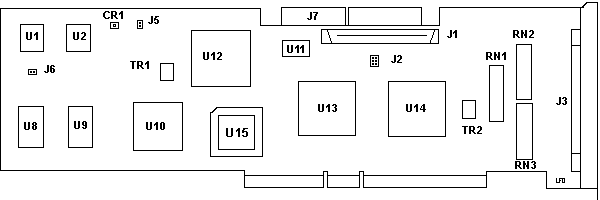
CR1 LED
J1 50 pin
SE SCSI connector
J2 Factory use
J3 C-68 DFW SCSI connector
J5 Leave open. Not used.
J6 Boot Enable
J7 FW SE SCSI connector
RN1,2,3 Used for RS6K stuff
TR1 PTC resistor for internal bus
TR2 PTC resistor for external bus |
U1 61G3929, SCSI BIOS, Odd
U2 61G3930, SCSI BIOS, Even
U8,9 Sony CXK581000AM-70LL
U10 AMD N80C186-20
U11 40.0000 MHz osc
U12 82G2645 Int SE SCSI ctrlr
U13 61G2323 MCA Bus interface
U14 52G9707 Ext Diff SCSI ctrlr
U15 empty (unused even in RS6K)
1 |
RN1,2,3 Removed on RS/6000 systems
when a high-reliability configuration is used (one of them there "Y" arrangements
illegal to normal SCSI users).
The SCSI-2 Differential Fast/Wide Adapter/A supports an internal
single-ended and an external differential SCSI bus.
FRU 11H3599
To date, all attempts to get this RS/6000 adapter to work in a PS/2
have failed. Although the chipset is the same as on the Fast/Wide, the
rev .71 flash update does not recognize a F/W chipset.
How Many is Enough?
Tim Clarke uttered this after
a pint of warm beer:
All **IBM** SCSI CBIOS-flavour (i.e. *not* FD MCS700 OEM)
will share IRQ14 and you only need one BIOS ROM enabled to drive multiple
adapters. So, for example you *should* be able install (in the same slot-type,
please) IBM F+W SCSI-2 "Corvette", IBM SCSI w/cache ("Spock") and IBM SCSI
w/o cache ("Tribble") in the same PS/2. No naughties like AHA1640, Storage
Dimensions unless you disable their BIOS ROMs and assign a different IRQ.
OS Limits
Not all Micro$haft products support multiple IBM SCSI adapters
gracefully. W9x cannot handle shared IRQs and will drop into MS-Doze (In)compatibility
mode. Win NT, OS/2, Linux and other unixes can handle shared interrupts.
J7 Pinout
 IBM's
patent info/Tech Discovery Bulletins, TDB
identifies the
Burn/Alive/TXD/RXD as being used to flash certain components. Basically,
factory use only. IBM's
patent info/Tech Discovery Bulletins, TDB
identifies the
Burn/Alive/TXD/RXD as being used to flash certain components. Basically,
factory use only.
Fast/Wide in 8590/8585
If you don't have a Type 4 complex on a 95A (dual serial/dual
parallel), you may not be able to use some features of the Fast/Wide, most
notably Internal/External Bus Mode. You need to run
SCSI2FW.EXE
to update the system partition.
FRU 11H7660
Much to my suprise, the 11H7660 configures fine, flashes
to .71, and works like a normal F/W.
Front 11H7660
DFW Rework
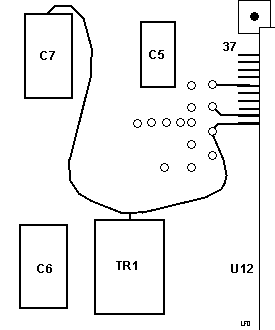 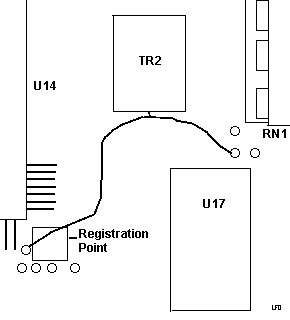
Rear 11H7660
DFW Rework
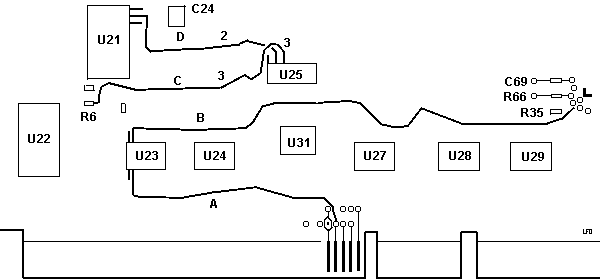
Rework A comes off the fourth MCA contact.
Rework B comes off the solder pad marked with a V.
Rework C comes off the third pin on the upper left of U23.
Rework D comes off the second pin of U23.
Jim Shorney rains on our parade- he warns that foil cuts may have been
made in addition to the rework wires.
Enhanced Differential
SCSI Fast/Wide Adapter FRU 52G3380 (RS6K 4-C)

CR1 LED
J1 FW
SE SCSI connector
J2 50 pin
SE SCSI connector
J3 C-68 DFW SCSI connector
J5 Leave open. Not used.
J6 Boot Enable
J7 Factory use
RN1,2,3 Used for RS6K stuff
TR1 PTC resistor for internal bus
TR2 PTC resistor for external bus
U1 88G1094, SCSI BIOS, Odd |
U2 88G1095, SCSI BIOS, Even
U4 82G2645 Int SE SCSI ctrlr
U5,18 Nat'l Semi DS36954
U9,10 Sony CXK581000AM-70LL
U11 AMD AM186 EM-40VC
U12 88G1092
U13 88G1093
U16 61G2323 MCA Bus interface
U17 52G9707 Ext Diff SCSI ctrlr
Y1 40.0000 MHz osc
0 |
DS36954 - Quad
Differential Bus Transceiver
AN-904: Application
Note 904 An Introduction to the Differential SCSI Interface
The SCSI-2 Differential Fast/Wide
Adapter/A is a dual-ported, fast and wide (two bytes wide) SCSI Micro Channel
adapter that provides synchronous SCSI bus data rates of up to 20MBps.
The internal SE port is capable of addressing up to seven SE SCSI devices
and the differential external port is capable of addressing up to seven
differential SCSI devices, providing a maximum of 14 devices per adapter.
The number of physical devices attached to each port is limited by SCSI
bus cabling restrictions. The external differential port can support
a total cable length of 25 meters (82 feet).
Additional system, subsystem and
high-availability connections are also available with the differential
system-to-system and Y-cable features.
Corvette vs. Enhanced Corvette Turbo
William R. Walsh wrote:
Quick testing in the Server 95(a) upgraded to P180MMX shows a
bit of a speed impovement over the standard issue Corvette. Using a Seagate
10,000 RPM SCA hard disk and UZ's "no-LED" driver, I got:
Corvette:
Max 11.5MBP/S
Min 10.6MBP/S
Avg 11.1MBP/S |
Enhanced Corvette Turbo:
Max 13.7MBP/S
Min 13.0MBP/S
Avg 13.9MBP/S |
The Enhanced Corvette Turbo shows a CPU utilization of 10.4% compared
to the Corvette's 10.1%. Tests were run using the Simpli Software HDTach
tool, which was used before during SPOCK-206 NT driver testing.
Possible
MCA Bus Controller Problems (RS/6000 Specific,
but may affect PS/2s?)
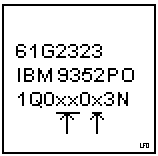 Some MCA bus controller chips, P/N 61G2323 (Malibu), can cause system problems.
The third line is the datecode. The following datecodes are suspect:
Some MCA bus controller chips, P/N 61G2323 (Malibu), can cause system problems.
The third line is the datecode. The following datecodes are suspect:
1Q010013N
1Q010023N
1Q03K023N
1Q04T003N
1Q06K013N
The entire datecode is not bad, but because of this,
the whole lot is suspect. If you have any of the symptoms below,
keep in mind the SCSI-2 F/W adapter may be the problem.
There are three types of symptoms you may see....
1) Checkstops (SIO BUS 0 or 1 PARITY)
2) System Hang/Unresponsive
3) DMA_ERR in the Error Log
Affected Controllers
SCSI-2 F/W Controller Type FRU p/n
U-location
* Integrated
52G4325 U60
MicroChannel SE
11H3600 U5
MicroChannel DE
11H7660 U13
Enhanced Microchannel DE 52G3380
U16
Note (*):
The Integrated SCSI-2 F/W controller is the one on the I/O planar of the
7012-380/390/39H and 7012-3AT/3BT/3CT systems.
PTC Function
There is one PTC for the internal SCSI bus and another
for the external bus. The PTC protects the SCSI bus from high currents
due to shorts on the cable, terminator, or device. It is highly unlikely
that the PTC resistor can be tripped by a defective adapter.
A fault (short circuit) causes an increase in PTC resistance
and temperature. The increase in resistance causes the PTC resistor to
halt current flow. The PTC resistor returns to a low resistive and low
temperature state when the fault is removed from the SCSI bus or when the
system is powered off. Wait 5 minutes for the PTC resistor to fully cool,
then reset.
MF-SM Series MF-SM150
PLCC Socket on Fast/Wide
The PLCC Socket U7 was possibly to provide a RS/6000 Bios, and
the jumper J5 might have been to enable it. Documentation for the RS/6000
says that PLCC socket is unused. The related 4-4 [11H4779] SCSI-2
SE High Performance Internal/External I/O Controller has a chip (FRU 52G7507)
in the PLCC socket. The 4-4 is the only F/W related SCSI adapter to have
the PLCC chip installed..
Jumpers on Fast/Wide
The results of shorting the jumpers ranged from no difference,
slight performance hit (%10 overhead increase) or a system-halting error.
Leave them off. RS6000 documentation says the jumpers are to be left open.
J5 grounds out pin
33 on the internal SCSI controller 82G2645. Purpose unknown.
J6 grounds out pin
1 of U1 and U2. Marked "Boot Block Enable"
68
pin Internal Connector on D F/W SCSI Adapter
This is a "mini-Centronics" or a Vesa Media Channel plug.
The ANSI moniker for it is a "P" plug. Also seems to be used for SCA drives...
Hmm...
AMP (and Tyco) # 1-557089-2
Looks like THIS
or if you want the page go HERE
Newark Electronics 97F8813
CHAMP. 0.050 I Series Interface Connectors For VMC Applications:
68-Position
Designed for use with 30 AWG solid conductors on .064mm (.025")
centers. look HERE
Molex 71660i Molex part 15-92-3068
1.27mm (.050") Pitch
EBBI™ 50D - Receptacle, Vertical, IDT 71660i Looks like THIS
Terminates to 30 AWG solid or stranded.025" ribbon cable
or laminated discrete wire cable
Drive connector
The 68 pin crimp-on device connector. Dalco 59611
$4.25

SCSI
device and adapter configuration flexibility
Systems with the enhanced SCSI device and adapter support
allow up to 8 IBM PS/2 SCSI adapters of any type to be installed in a single
system. The maximum number of SCSI devices which many be configured in
these newer systems has also been increased from 60 to 120. However,
other factors, for example, the type of devices (optical, etc.), cooling
requirements, or power consumption of the devices may limit the number
for a particular system.
SCSI Device
Order
SCSI device logical ordering and hard drive letter assignment
(e.g. C:, D:) sequence is determined by the SCSI adapter slot numbers,
internal or external SCSI bus connection, and SCSI ID of the connected
devices.
Adapters are scanned for SCSI devices beginning with the
SCSI adapter in the lowest numbered slot. Devices connected to the
same adapter are logically ordered according to device SCSI IDs in order
from 7 to 0 and then from 15 to 8 according to the priority scheme defined
by the SCSI standard. Devices connected to a SCSI-2 Fast/Wide adapter's
internal bus connector are ordered logically before devices connected to
the external bus of the same adapter.
Maximum SCSI
Devices Supported
Wide SCSI devices support 16 possible SCSI ID values.
The adapter uses one these values; therefore, the SCSI-2 Fast/Wide adapter
can connect up to 15 fast and wide devices internally or externally in
any combination using the remaining ID values. Narrow SCSI devices
support 8 possible SCSI ID values; therefore, up to 7 narrow SCSI devices
can be connected to the internal or external SCSI busses in any combination
using the remaining ID values. Wide and narrow devices may be mixed
on the same internal/external bus by using the proper combinations of SCSI
bus cables, terminators, and/or SCSI connector convertor adapters.
NOTE: Use of a 8 bit
(Narrow) cable forces the controller to default to only 7 devices supported
on that port, even if all devices on that cable are Wide.
Fast POST Consequences
Some newer systems also provide a FAST POST option which
may be selected from the system configuration menu or from the IBM logo
screen. When this option is selected, the system will not check for
the presence of newly added SCSI devices unless F1 is also pressed while
the IBM logo is displayed. Newly added SCSI devices will not be configured
nor will an error occur if the fast post option is chosen as the default.
To access the system configuration program, press F1 while the IBM logo
screen is displayed to configure the new SCSI device(s) initially.
ADF Sections
@8EFC.adf
4/10/95
I/O Address
I/O address for the adapter. Each adapter must have a
unique address range.
<3540-3547>, 3548-354F,
3550-3557, 3558-355F, 3560-3567, 3568-356F, 3570-3577, 3578-357F, 3578-357F
DMA Arbitration Level
Arbitration level used by the adapter to transfer data.
<C>, D, E, 8, 9, A, B,
1, 3, 5, 6, 7
SCSI Adapter Address (ID)
SCSI ID of the adapter. Usually ID7, unless you have specific
requirements.
Adapter IDs available are: <7>,
6, 5, 4, 3, 2, 1, 0
Move Mode Support
Enable or Disable Micro Channel Subsystem Control Block
Move Mode This is the second mode of SCBA (first is locate mode) which
permits the system processor to move the subsystem control blocks to the
adapters directly.
<Enabled> or Disabled
Wait State Support
Enable or Disable Bus Master wait states. If the target
expansion card is an older card, it may not be able to process commands
or data from the busmaster fast enough, and when queried by the busmaster,
it replies with "not ready". By inserting a wait state, the slower card
has more time to signal "ready". Enabling wait states can slow your busmaster
down.
<Disabled> or Enabled
Data Parity Exception Handling
This Adapter can generate and detect data parity on Micro
Channel. Data parity must be supported on both ends of an across-the-bus
transmission in order for this error detection process to be effective.
A data parity enable (-DAPAREN) bus line to the system and other expansion
boards is enabled when data parity is being used. If the System does not
support Data Parity Exception Handling, this feature will always be disabled.
<Enabled> or Disabled
Selected Feedback Return Exception
Whether a busmaster will report errors detected in the
select-feedback-return process.
When enabled, the busmaster monitors the selected feedback
return and card-selected feedback buslines. The return line tells the master
that it's target expansion board is responding properly to being addressed
for a read or write operation. If the bus master does not recieve this
signal (and SFR has been enabled) it may mean that the expansion board
is not operating properly or that the signals themselves are not properly
traveling across the expansion bus. This error causes the master to immediately
halt the transfer in progress and notify the host system of the error using
an interrupt. NOTE: The SFR must be
ignored for PC compatibility. If the System doesn't support the Selected
Feedback Return feature, it will always be ignored.
<Enabled> or Ignored
100ns Streaming Data Transfer Support
This provides better performance. It will always be disabled
if the system doesn't support it.
<Enabled> or Disabled
Target Mode
Target mode should be disabled only if this system is
sharing SCSI devices with another system and there are more than 15 devices
to be shared. Only 15 devices can be configured on each adapter.
When
target mode is enabled, this adapter appears as a processor device on the
other system and unless you have specialized software that can communicate
between the two systems through these processor devices (peer-to-peer communication),
there is no advantage in having
target mode enabled. When target
mode is disabled, this adapter does not appear as a device to the other
system, and one more device can be shared by the two systems. If
your system is not sharing any SCSI devices with another system on this
adapter, it does not matter whether you enable or disable target mode.
<Enabled> or Disabled
SCSI Disconnect
Disconnect is a SCSI-bus procedure in which a device logically
stops communicating with the adapter during certain operations and then
reestablishes communication with the adapter when the operation is complete.
Disconnect should not be confused with the 'Presence Error Reporting' option
for a device in 'Set and view SCSI device configuration.' If you
are using an operating system that is single-threaded and issues commands
to only one device at a time (such as DOS or Win95),
disabling SCSI disconnect might result in a slight performance improvement.
If your operating system is multi-threaded (such as OS/2), disabling SCSI
disconnect will degrade the performance of the SCSI subsystem.
<Enabled>
or Disabled
Fast SCSI - External
If you have Fast SCSI devices attached externally, enabling
Fast SCSI improves performance :
- One external SCSI device enclosure model 3511.
- Up to three external SCSI device enclosures model 3510.
- Any external configuration where SCSI cable length isn't >
3 meters.
<Disabled> or Enabled
Wide SCSI messages - External
This should be 'Enabled' unless you have a Wide SCSI device
attached to the adapter through a narrow (8 bits wide) external interface
cable.
<Enabled> or Disabled
Wide SCSI messages - Internal
The setting for this should be 'Enabled' unless you have
a Wide SCSI device attached to the adapter through a narrow (8 bits wide)
internal interface cable.
<Enabled> or Disabled
Internal/External Bus Mode
'Separate', SCSI devices on external SCSI bus connector
can have the same SCSI ID setting as other SCSI devices connected to
internal SCSI bus connector on the same adapter.
'Combined', all devices connected to this adapter
must have unique SCSI ID settings regardless of which SCSI bus connector
is used to attach the devices. Default is 'Separate' unless you are
using an operating system device driver that does not support independent
operation of the internal and external SCSI busses on the adapter.
<Separate> or Combined
System Determined
ROM Address Range
Address of the 32K block of memory assigned to the adapter.
Only one SCSI Adapter will have the ROM assigned, and any other SCSI Adapter
installed will share that address range.
ESDI Requirements
If the ESDI adapter is also installed, then the address
of the SCSI adapter must be greater than the ESDI adapter address.
ESDI Requirements
If the ESDI adapter is also installed, then the address
of the SCSI adapter must be greater than the ESDI adapter address.
9595 Main
Page
|
 Some MCA bus controller chips, P/N 61G2323 (Malibu), can cause system problems.
The third line is the datecode. The following datecodes are suspect:
Some MCA bus controller chips, P/N 61G2323 (Malibu), can cause system problems.
The third line is the datecode. The following datecodes are suspect: